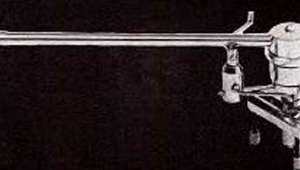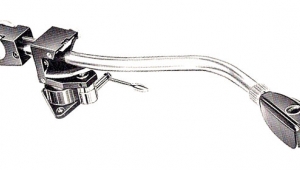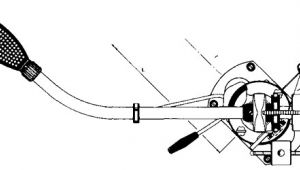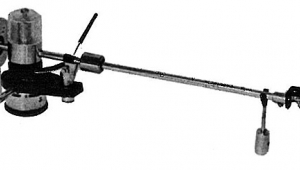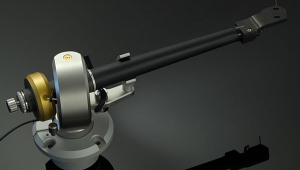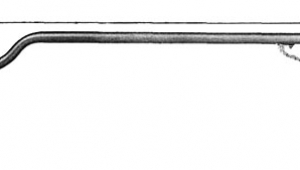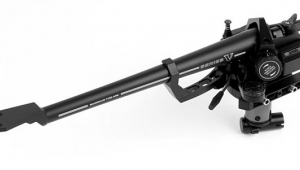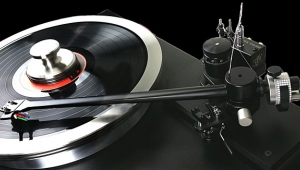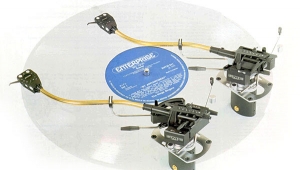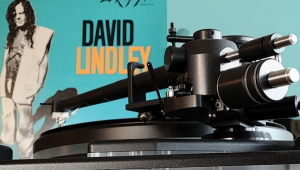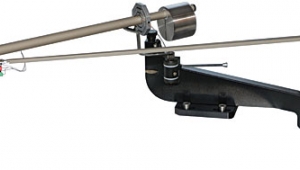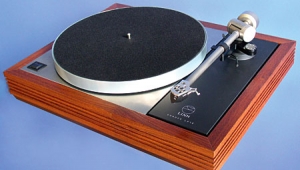| Columns Retired Columns & Blogs |
Airtangent tonearm Page 5
That goes for every cartridge I used—each responded with more detail. And since detail is the staple of such desirable sonic commodities as air, space, nuance, intonation, and harmonies, just about every recording became an exciting adventure.
Most of the drama materialized in a soundspace presentation of billowing proportions. The soundstage not only grew considerably as far as width and depth was concerned, but became more coherent and seemed filled to capacity with ambience cues. The performers, in general, remained in their accustomed positions, but now their presence was more prominent and clearly outlined. While better imaging contributed considerably, the more gratifying contribution was the airy surround enveloping each performer. Everyone's presence was more profound, and the illusion of a more credibly recreated musical event was more pronounced. The music could be as diverse as the solemn Cantate Domino, or Larry McNeely's bluegrass on Sheffield (LAB-9), and the presentation was clearly perceived in a more involving fashion.
The most-asked question about the Airtangent was the low end. "How's the bass? Does it go low enough?" they would ask. What I heard through the Divas did not give me an indication to suspect a shortfall in low-bass performance. The wallop and push were there to render full orchestras credibly, with enough attack and excellent dynamics.
In fact, the definition in this area, as heard on the Telarc Carmina Burana, was remarkable. The impacts of bass drums and the decays that followed were rendered with great clarity. And when I played Robert Gibson's piece for double-bass and oboe (Spectrum SR-313), it seemed I could count each vibration.
In keeping with its ability to keep every note and nuance in place, the Airtangent displayed an unremitting ability to portray most of each recording's essential attributes, good or bad, starkly intact. Though such thorough truthfulness can become a liability, the situation here was the direct opposite. Sure enough, a number of recordings were brought to their knees, revealing a few very unsavory character flaws. But most of the time these exposes were exciting. Many recordings could now be seen in a more fascinating light than before, and were, therefore, sonically more eloquent.
Improved dynamics also contributed significantly to the second coming of many of my recordings. I repeatedly found myself marveling at the added sock, push, and punch of many favorites. The Chesky Scheherazade (RC-4) was a good case in point. The shudders and throbs of full orchestral assaults pulsated with more energy and involved more acoustic space.
Digging out old favorites can very dramatically point to sonic gains. The "Most of Us are Sad" cut from The Eagles album (Asylum SD-5054) did just that. The voices had more power, the drums kicked harder, and the bass guitar had additional strength. That's not to imply any loss of delicacy. Many new nuances sprang forth with vim and vigor, and the articulation of transients and harmonies was rendered with remarkable clarity.
The Airtangent also had a say in trackability. The same cartridges had been used in other arms, namely the SME V and WTA, and, while the results were generally gratifying, a certain loss of control at high recording levels was apparent. Loud passages would tend to become edgy and turn nasty.
A good example is Van Morrison's Moondance album (WB BSK-3103). Here Van has been recorded to give his already ragged voice a very peaky edge. I didn't realize how much of an improvement was possible until the Airtangent was used. His voice was still as raucous and shrill, but now it was much more revealing of the inner complexities which were a blur at other times. As an added bonus, the instruments of the band could also be heard more vividly, with more focus and far more space, making for a significantly improved experience.
I thought it only fitting that the Airtangent be compared with the SME V. This remarkable incarnation of a pivoted approach has become a benchmark of sorts for tonearms. Its price also benefits handsomely from mass production, making it a more accessible product at $2000.
As fine a product as the SME V is, it does have a few shortcomings. The first has to do with VTA changes. Curiously enough, even though this arm has no provision for adjusting the azimuth of a cartridge, azimuth can be disturbed while resetting VTA. It can happen when the main support pillar of the SME V is canted while increasing VTA. Since the VTA screw is located off to one side of the arm pillar, it pushes harder on that side when turned to raise the back of the arm. An azimuth change results unless the pillar is manually restored to a vertical position; an upward pull on the anti-skate dial support does it for me. Sumiko maintains that tightening the clamps gripping the arm pillar will restore it to a vertical position, but my experience does not bear that out.
The second shortcoming concerns the large diameter of the armtube at the pivot end. When going for very low VTA settings, especially if a warped record is played, the back of the arm can end up too low, and hit the outer edge of the record. This problem becomes acute when playing the innermost cuts.
It might have been more informative to pit the Airtangent against the ET-2, since both are tangential-tracking, air-bearing designs. I feel, however, that bringing in the SME V at its $2000 price is more realistic. Anyone considering the ET-2, a terrific buy at $900, is not likely to suddenly opt for a $3200 product. $2000 is a bit closer.
Both tonearms are excellent performers, but differ greatly in concept and execution. For me, the ergonomics clearly favor the Airtangent. My priorities call for the ability to adjust everything, and the Airtangent is more complete. In day-to-day use, both are easy to live with. The cueing mechanisms are equally effective, but the motor-driven Airtangent approach has a special appeal for me. Sure, it's one more thing prone to failure, but it is also ever so much more fascinating technically. Of course, the end-of-record lift feature speaks for itself—a winner if there ever was one.
Mounting a cartridge in the SME V is a snap; and I have it down to about 10 minutes now. But the Airtangent, even though the initial setup takes much longer, out-features the SME V with its interchangeable air-bearing sleeve assemblies. Here cartridge changes happen in 30 seconds or less, and with perfect registration of all settings save VTA. If you recall, that's an extremely easy task on the Airtangent.
Be aware that the extra air-bearing sleeve/armtube comes at additional cost, since only one is included with each Airtangent. Furthermore, if only one cartridge is to be used, all of this flexibility is a moot point. But you tell me—What audiophile will not jump at the chance to change cartridges that conveniently?
- Log in or register to post comments
